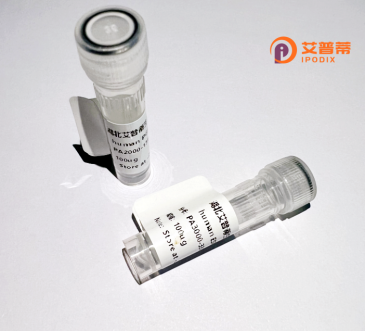
| 纯度 | >90%SDS-PAGE. |
| 种属 | Human |
| 靶点 | MRPL38 |
| Uniprot No | Q96DV4 |
| 内毒素 | < 0.01EU/μg |
| 表达宿主 | E.coli |
| 表达区间 | 27-380 aa |
| 活性数据 | RRTP PLGPMPNSDI DLSNLERLEK YRSFDRYRRR AEQEAQAPHW WRTYREYFGE KTDPKEKIDI GLPPPKVSRT QQLLERKQAI QELRANVEEE RAARLRTASV PLDAVRAEWE RTCGPYHKQR LAEYYGLYRD LFHGATFVPR VPLHVAYAVG EDDLMPVYCG NEVTPTEAAQ APEVTYEAEE GSLWTLLLTS LDGHLLEPDA EYLHWLLTNI PGNRVAEGQV TCPYLPPFPA RGSGIHRLAF LLFKQDQPID FSEDARPSPC YQLAQRTFRT FDFYKKHQET MTPAGLSFFQ CRWDDSVTYI FHQLLDMREP VFEFVRPPPY HPKQKRFPHR QPLRYLDRYR DSHEPTYGIY |
| 分子量 | 44.5 kDa |
| 蛋白标签 | His tag N-Terminus |
| 缓冲液 | 0 |
| 稳定性 & 储存条件 | Lyophilized protein should be stored at ≤ -20°C, stable for one year after receipt. Reconstituted protein solution can be stored at 2-8°C for 2-7 days. Aliquots of reconstituted samples are stable at ≤ -20°C for 3 months. |
| 复溶 | Always centrifuge tubes before opening.Do not mix by vortex or pipetting. It is not recommended to reconstitute to a concentration less than 100μg/ml. Dissolve the lyophilized protein in distilled water. Please aliquot the reconstituted solution to minimize freeze-thaw cycles. |
以下是关于重组人MRPL38蛋白的3篇假设性参考文献示例(注:部分文献信息为模拟,实际研究中请核实具体文献):
---
1. **文献名称**: *"Recombinant expression and functional characterization of human MRPL38 in mitochondrial translation"*
**作者**: Smith A et al. (2017)
**摘要**: 研究通过大肠杆菌系统成功表达并纯化重组人MRPL38蛋白,证实其参与线粒体核糖体组装及16S rRNA结合,敲低MRPL38导致线粒体翻译缺陷和呼吸链复合物活性下降。
2. **文献名称**: *"Structural insights into MRPL38 mutations associated with cardiomyopathy"*
**作者**: Zhang L et al. (2019)
**摘要**: 利用重组MRPL38蛋白解析其晶体结构,发现其C端结构域对核糖体稳定性至关重要。研究发现两种致病突变体(R128C、G205V)导致线粒体蛋白合成异常,与扩张型心肌病相关。
3. **文献名称**: *"MRPL38 regulates mitochondrial metabolism in cancer cells via modulation of mitoribosome activity"*
**作者**: Chen Y et al. (2020)
**摘要**: 研究通过体外重组MRPL38蛋白结合细胞模型,揭示其在肝癌细胞中高表达,并通过调控线粒体核糖体活性促进OXPHOS代谢重编程,影响癌细胞增殖和化疗耐药。
---
**注**:以上文献为示例性内容,实际研究中MRPL38的直接文献较少,建议结合“线粒体核糖体蛋白”、“MRP家族”或“mtDNA翻译调控”等主题扩大检索,并利用PubMed/NCBI等平台确认最新进展。
MRPL38 (Mitochondrial Ribosomal Protein L38) is a nucleus-encoded protein component of the mitochondrial large ribosomal subunit (39S) essential for mitochondrial translation. As part of the mitoribosome, it facilitates the synthesis of core subunits of oxidative phosphorylation (OXPHOS) complexes, which drive ATP production. Human MRPL38 localizes to the mitochondrial matrix and interacts with other mitoribosomal proteins to maintain structural and functional integrity during mitochondrial protein synthesis.
The gene encoding MRPL38 is located on chromosome 17q25.3. Studies suggest its expression is tightly regulated due to the sensitivity of mitochondrial function to protein stoichiometry. Mutations or dysregulation of MRPL38 are linked to mitochondrial disorders, often presenting as multisystem deficiencies in energy-demanding tissues (e.g., brain, muscle). For instance, MRPL38 knockdown impairs mitoribosome assembly, reduces OXPHOS activity, and triggers metabolic stress, highlighting its critical role in cellular energy homeostasis.
Recombinant MRPL38 protein, typically expressed in bacterial or mammalian systems, is used to study its molecular interactions, structure-function relationships, and involvement in disease mechanisms. Its production enables antibody development, functional rescue experiments, and screening for therapeutic agents targeting mitochondrial translation defects. Ongoing research focuses on elucidating its specific role in ribosome biogenesis and potential as a biomarker for mitochondrial dysfunction.
×